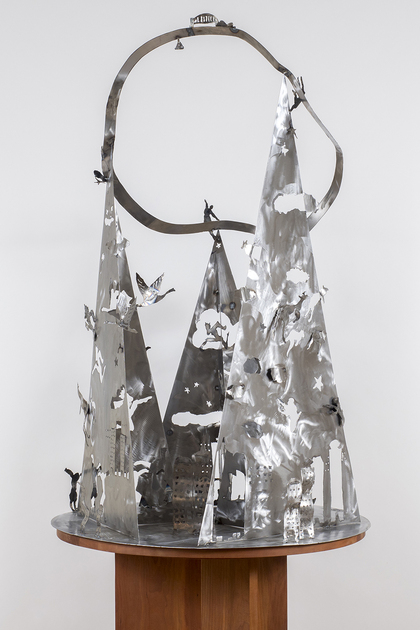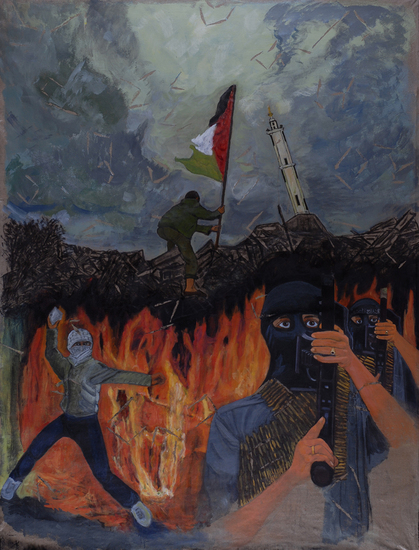
R
E
V N
E
X
T
I Go Where I Go: Interview With Setsuko Ono
Upon retiring from a 28-year career in the World Bank in 2003, Setsuko Ono moved from one family vocation to another, leaving the banking profession into which she had followed her father and, like her sister Yoko some years before, pursuing a career in art. Having become best known for public sculptures in steel, Setsuko is now moving into the gallery for two consecutive presentations at the Daiwa Anglo-Japanese Foundation and then Asia House, both in London. Ahead of her shows, ArtAsiaPacific sat down with the artist to speak about her artistic career and the influences that have shaped her practice.
Moving from banking to art is quite a career change. What prompted it?
I wanted to become a banker because my whole family—both on my mother’s and father’s sides—were bankers, but the real reason is that my father got sick in his early fifties and had to stop working, and I thought I had to take after him, so I went into the World Bank. It’s an extraordinary place where you have very difficult work to do—development is something really very challenging—and I needed to have some kind of relaxation, so I decided to go to an art school near the World Bank [headquarters in Washington, DC]. I have been making drawings all my life, but I started to make sculpture and it was really fascinating. Sometimes I would work until midnight. I would go to the studio and that gave me energy to work at the bank.
The one thing I’ve noticed is that in the work of the World Bank, you have an objective and you work very hard for it but then some political intervention makes it impossible to attain the objective. I’m always giving this comparison, but it was a little bit like sculpting a beautiful face, and you really put a lot of effort into trying to understand the grain of the stone, and it comes out very nicely but with the last movement of the chisel you hit it and the nose comes off. The World Bank’s work was like that, so in a sense sculpture gave me more control over the work I was doing.
Did you find any parallels between the two professions?
I don’t think that there are parallels, but one thing is that you need a lot of creativity in the World Bank to try and find out what you can do for development—a different kind of creativity.
Was it a challenge, as an already successful professional, to begin a new career?
Not really, because first I was doing art and sculpture as hobbies, as a sideline to my main work, but then I went into retirement, and before then I didn’t spend time trying to develop my career as an artist. But suddenly, when I knew that in two or three months I would retire, I read an article in the Washington Post about the Havana Biennial, and my husband was working on one of two big volumes on Cuba and the US in Africa, so he was going there all the time. I just asked him if he could give the Cubans my portfolio and see if I could exhibit in Havana. It was accepted, and that’s how it began.
What is your opinion on the current state of arts education? Is it beneficial for artists to do other things first, rather than taking the art school route?
That’s a really hard question. I think it depends on individuals. And I think it was good for me that I did something else before.
You specialized in Africa at the World Bank. Has that influenced your work at all?
I worked first in Africa, and I’ve also worked in Latin America a lot. Yes, I’m very interested in both continents, they’re very rich in culture, very beautiful. The people—contrary to images that you get—they work hard, and they’re very charming. So yes, I really like Africa.
I always work unconsciously, so people ask me if there are painters that influence me, and actually, probably I have been influenced by all the experiences I’ve had in my life, but not consciously.
How did you settle on the materials and style in which you work?
I never gave up painting, but I knew nothing of sculpture when I started. At first, I used all the materials—wood, stone, plastic, bronze—and one day after I had finished using all the other materials, I said, “Well, I should do steel.” That was because I was very scared of steel, and of all the machines, the welding, the fire. And when I started it was wonderful, because it is a very flexible material. People think of it as something very hard, harsh, heavy. But you can coax out of it something very light, fragile, vulnerable, and so I became obsessed, and then I just decided to do sculptures in steel.
In some of your works, you approach political issues both past and present—the Warsaw Uprising, the occupation of Palestine, the siege of Aleppo—what motivates you to address subjects such as these?
Well, I don’t tell myself, “Oh, I can do it.” It’s just something that comes out of me. I get so furious about things that are happening. I suppose if I had been a politician I would have just screamed, and it’s something like that, only it’s done through painting.
Do you think artists can productively comment in their art on issues with which they are not otherwise engaged?
I think we’re all engaged. I mean we live in the world, and injustice in the world is part of our lives.
You’re in a relatively unique position to answer this question, as someone with a long career in an institution with a massive global impact, and more recently as an artist, do you believe art is capable of having a significant impact on the world?
Oh yes. It’s difficult to explain how, because art gets into people’s lives in different manners, and also there are differences between societies. There are societies that really respect art. I think it’s difficult to say exactly how art can influence the world. But I think for sure that it does. An artist has to be extremely free, and make their work spontaneously from what he or she individually feels is necessary.
With all this freedom and unconsciousness, how do you decide what direction to take with your practice?
Well. . . I don’t have a direction. I go where I go.
And on that note, what’s next for you?
I really don’t know!
Ned Carter Miles is the London desk editor of ArtAsiaPacific.
Setsuko Ono’s solo exhibition at the Daiwa Anglo-Japanese Foundation Japan House, London, is on view until March 9, 2018.
To read more of ArtAsiaPacific’s articles, visit our Digital Library.






